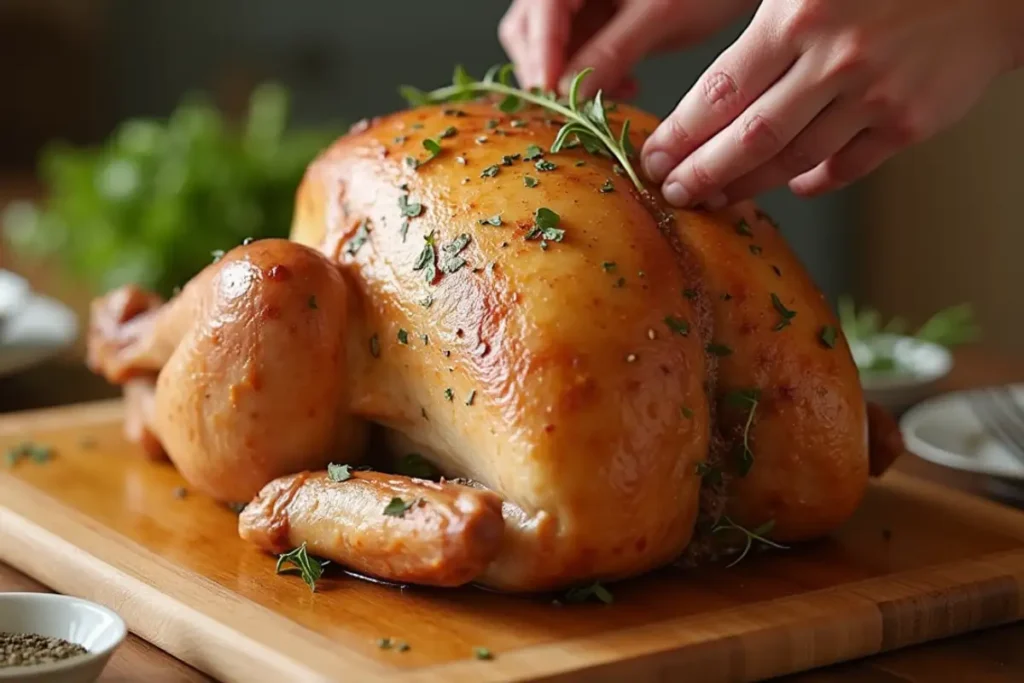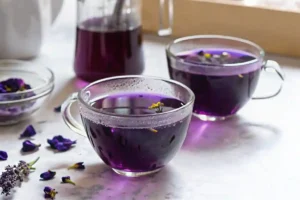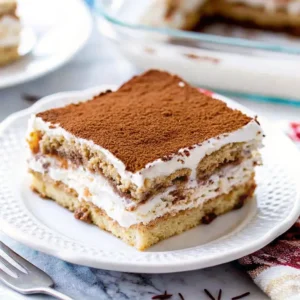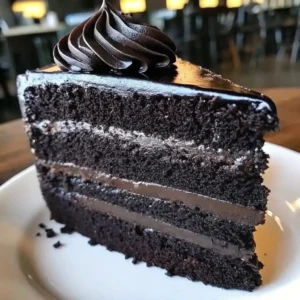Table Of Contents
Table of Contents
Do I need to put butter under turkey skin? The process of cooking the perfect turkey causes endless debates, particularly on whether or not you should apply butter to the skin. This technique has become an increasingly popular method of giving flavor and moisture to turkey meat. Is it necessary, and will it affect the flavor? Let’s explore the answers.
In this article, we’ll look at the rationale behind buttering turkey skins, talk about different options, and give step-by-step directions to help you make the most of your Thanksgiving feast. No matter if you’re a beginner cook or an experienced cook this guide will address any questions you may have regarding turkey preparation.
Why Do People Put Butter Under Turkey Skin?
Enhancing Flavor
One of the main reasons that cooks use butter to cover the surface of turkeys is to impart the meat with the flavor. Butter is often mixed with garlic, herbs, and spices to allow these flavors to penetrate the meat while it is cooking.
The butter forms a delicious layer that smothers the turkey in its melting and provides a richer flavor and a more complex flavor in comparison to the plain seasoning that is applied in the flesh.
Improving Moisture Retention
Turkey breast meats are known for drying out while cooking. Applying butter on the skin creates a barrier to keep moisture in. When the butter melts it releases fats, which keep the meat moist and tender even after prolonged roasting time.
Does Butter Under the Skin Make a Difference?
The quick answer is that it’s possible! Applying butter on the skin will provide benefits in terms of taste and texture. But, the impact is contingent on how the butter is applied and cooked.
- Flavor Effect: The herbs and seasonings mixed in the butter penetrate better when applied under the skin than if it is applied just on top.
- Moisture Lock Butter’s fat-rich content may slow the loss of moisture during cooking, which can prevent the meat from drying.
- Skin Crispiness Although butter is a great source of moisture for meats, it may assist in creating crispy, golden skin if applied correctly.
Some individuals may opt for alternative methods specifically those seeking to cut down on fat content or try different flavors.
Similar: If you’re looking for a comprehensive recipe that showcases this technique, refer to our article to the roast Turkey and Herb Butter: A Timeless recipe for the Holiday Season. It gives detailed directions on how to prepare a perfectly cooked turkey that is perfect for any holiday celebration.
Pros and Cons of Using Butter Under Turkey Skin
Pros
- Enhances Flavor: Adds depth and flavor to the turkey’s meat.
- Moisture Booster: Prevents dryness, especially in the breast region.
- Flexible: Allows for creative flavors using spices and herbs.
- Crispy Skin It gives a gold-crisp texture if cooked correctly.
Cons
- calories: Butter is a source of calories and might not be appropriate for all people.
- Unstable Application: It can be difficult to make butter evenly distributed throughout the skin without breaking it.
- Limited effectiveness: If not applied properly, butter could evaporate too quickly which can reduce the impact.
- Alternative needs: Those with dairy intolerances or dietary restrictions could require other alternatives.
How to Properly Apply Butter Under Turkey Skin
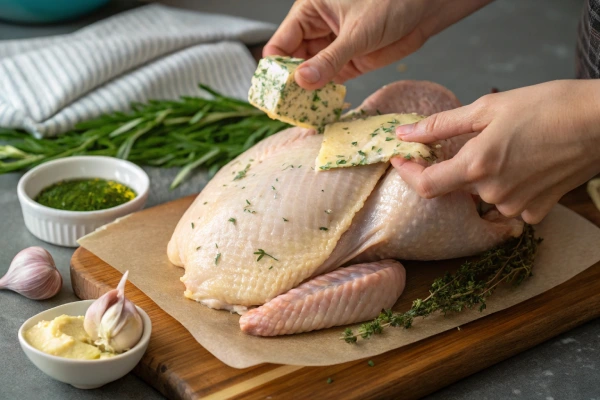
Tools and Ingredients Needed
- Tools:
- A sharp kitchen knife, or a chef’s shear
- Use a small spoon, spatula, or a tiny knife
- Paper towels to dry the turkey
- Ingredients:
- Butter that is unsalted (softened)
- Fresh herbs (thyme, rosemary and rosemary, sage)
- Garlic (minced or grated)
- Salt and pepper
- Optional additional ingredients: lemon zest, or paprika to add flavor
Step-by-Step Instructions
- Prepare the Turkey:
- The turkey is dried using paper towels to eliminate any excess moisture.
- Loosen the Skin:
- Carefully slide your fingers beneath the skin, beginning at the neck, creating pockets. Make sure not to pull the skin.
- Make the Butter Mixture:
- Blend softened butter with garlic, herbs, and other seasonings in the bowl of.
- Spread the Butter:
- Use a spatula, or your hands to push the butter mixture beneath the skin. Smooth it evenly over the breasts and the thighs.
- Season the Exterior:
- Add more olive oil or butter to the skin’s surface to increase crispness.
- Cook the Turkey:
- Cook the bird according to the recipe you have chosen If you like, sprinkle the turkey with a little oil every once in a while.
Alternatives to Butter for Flavoring Turkey
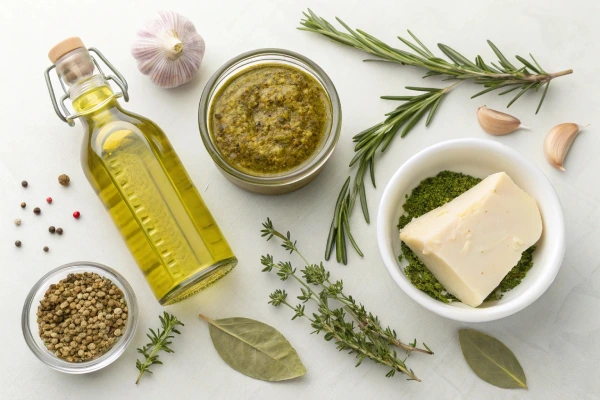
It’s not everyone’s preference to put butter on the skin of a turkey. This could be because of food restrictions, preferences, or just a desire to know there are many options to get the same or better outcomes.
Olive Oil
Olive oil is a great alternative to butter. It has a very high smoke point, which makes it perfect for roasting and imparts a delicate earthy taste to the bird.
- Benefits:
- Better than butter due to its fats that are not saturated.
- It gives a more crisp skin since it doesn’t contain water, as butter does.
- The flavor can be enhanced by adding rosemary, garlic, or lemon to add flavor.
- How to Use It:
- Rub olive oil on the skin, then under it.
- Mix in spices to create an emulsion for a more intense flavor.
Herb Pastes
Herb pastes made of parsley, thyme sage garlic, parsley, and a little olive oil are sprayed on the skin to give a flavor punch without fat.
- Why Choose Herb Pastes?
- Gives a concentrated flavor.
- It doesn’t contain a lot of calories or fats.
- The perfect choice for herb lovers and those who want the most aromatic turkey.
Marinades and Brines
A brining or marinating process for the turkey before cooking will allow the flavors to be absorbed into the meat, thus reducing the need for butter underneath the skin.
- Marinades Utilize acidic substances such as vinegar, lemon juice, or buttermilk, paired with spices and herbs to flavor and tenderize the turkey.
- Brines The saltwater mixture that is infused with bay leaves, garlic, and peppercorns keeps the turkey moist and adds flavor.
How to Achieve Crispy Turkey Skin Without Butter

The most common complaint about using butter for cooking is the possibility that it could make the skin oily instead of crisp. For those who want an attractive golden crisp surface, these are a few tried-and-true tricks:
- Pat the skin dry: Remove as much moisture as possible before applying any oil or seasoning.
- Baking Powder: Lightly dust the skin with baking powder, mixed with salt. This method draws the moisture and aids in browning.
- Roast at a high Temperature Then: Start cooking at 425 degrees for 20-30 minutes, then drop the heat to complete cooking. This will help the skin to get crisp in the beginning.
- Do not bast too often: Basting can introduce moisture, which can prevent the skin from properly crisping.
Common Mistakes to Avoid When Buttering Turkey Skin
Even experienced cooks sometimes make mistakes when working with butter under the skin. Here’s what to watch out for:
- Overstuffing the Butter: Too much butter can create uneven cooking, leading to greasy spots rather than even flavor distribution.
- Tearing the Skin: Rushing through the buttering process can rip the skin, allowing juices to escape and leaving the meat dry.
- Skipping Seasoning the Exterior: Butter under the skin doesn’t season the outside, so always season the surface generously.
- Forgetting the Resting Period: Allow the turkey to rest for at least 20–30 minutes after cooking. This ensures juices redistribute evenly, keeping the meat moist.
- Not Chilling the Butter Mixture: If the butter mixture is too soft, it may melt prematurely. Chill it slightly to make it easier to handle.
Tips for Seasoning Turkey Inside and Out
To get the best flavor You must prepare both the inside and exterior of your turkey.
Seasoning the Inside:
- Include aromatics such as garlic, onions lemons, and fresh herbs in the turkey’s cavity.
- Sprinkle salt and pepper on the cavity to ensure that the cavity doesn’t become overlooked.
Seasoning the Outside:
- Make use of a mixture of salt pepper, paprika, and garlic powder to create an even profile.
- Use olive oil or butter to create a base before making the addition of dry spice.
Under the Skin:
- Massage butter and herbs directly on the meat under the skin to increase flavor absorption.
Should You Baste the Turkey During Cooking?
The practice of basting is generally thought to be necessary, however, it may not be needed in the case of butter applied to the skin.
Advantages of Basting:
- It also helps retain moisture on the skin, which prevents the skin from drying out.
- Helps to develop a deep golden hue.
Disadvantages of Basting:
- It requires frequent oven openings that reduce heating and extend cooking time.
- It isn’t able to penetrate the meat and therefore, it only affects the skin’s outer layer.
Pro Tips: If you’ve used butter on the skin the basting may not be necessary because melting butter already helps to bast the meat on its own.
The Role of Aromatics in Turkey’s Preparation
Aromatics play a crucial function in enhancing flavor especially when they are combined with butter on the skin.
Best Aromatics for Turkey:
- Vegetable onions, carrots, and celery make the perfect base for a delicious meal.
- Herbs Themes, rosemary as well as sage and bay leaves to create earthy notes.
- Fruits Oranges, lemons to give a citrus twist.
How to Use Them:
- Place them in the turkey cavity to absorb the flavor from the inside out.
- Sprinkle them all over the roasting pan to give more depth to the drippings in gravy.
Cooking Techniques That Enhance Flavor
Roasting
The most well-known method of roasting, roasting produces an exterior that is golden brown while cooking to cook the beef evenly. Make use of a rack for roasting to let air flow and create a the skin is crisp.
Smoking
Smoking gives a deep smokey flavor. Smoking is a slow process, but it’s perfect for those who love cooking outdoors and want to experiment with something new.
Deep Frying
Deep-frying creates a crisp skin and moist, juicy interior in less time required to roast. It requires special equipment and safety measures because of the extreme temperature involved.
FAQs About Do I Need To Put Butter Under Turkey Skin?
Should you put butter under the skin of turkey?
Yes, putting butter under the skin of a turkey can enhance flavor and moisture. The butter melts during cooking, basting the meat from within and creating a richer taste.
What is the trick to crispy skin on turkey?
To achieve crispy skin, pat the turkey dry before cooking, season generously, and roast at a high temperature initially. Some chefs also recommend brushing the skin with oil or butter for added crispiness.
What is the secret to a moist turkey?
Brining the turkey before cooking is a popular method to lock in moisture. Additionally, basting with butter or broth and avoiding overcooking are key to keeping the turkey juicy.
How does Gordon Ramsay keep the turkey moist?
Gordon Ramsay emphasizes brining the turkey overnight and basting it regularly with a mixture of butter, herbs, and stock. He also recommends covering the breast with foil to prevent drying out during roasting.
Conclusion
So, do you need to put butter under turkey skin? It depends on your goals for adding moisture and flavor. Buttering the skin of a turkey provides an intense flavor, increased moisture, and self-basting effects that many cooks swear by. However, it’s not the only method to cook a delicious and juicy turkey.
Alternatives like olive oil, herb pastes, and brines may produce similar results, with minor differences in flavor and texture. The most important aspect of a great turkey is preparation. Whether you choose to use butter or not, ensure you thoroughly season your turkey, incorporate aromatics, and use the correct cooking technique for the best results.
Looking for more tasty recipes and cooking inspiration? Connect with us on Facebook at Dashtasty and become part of our foodie family.
